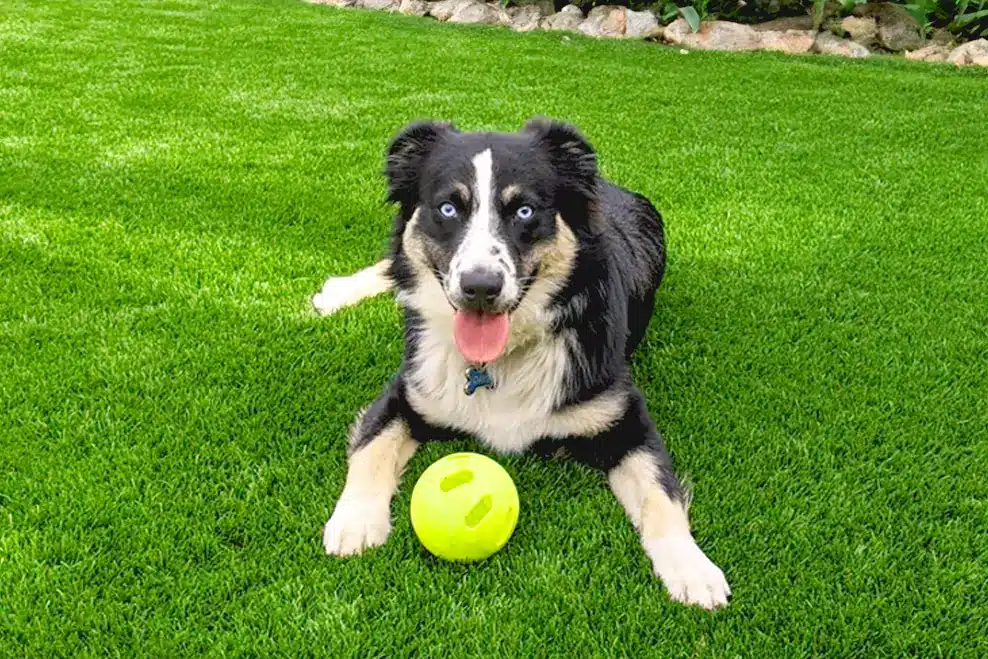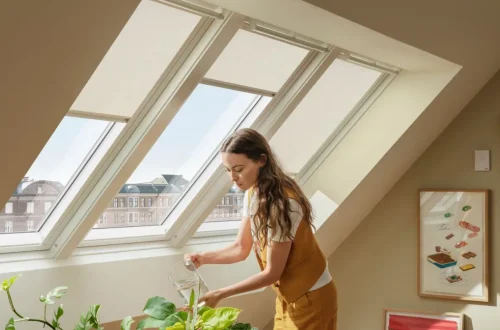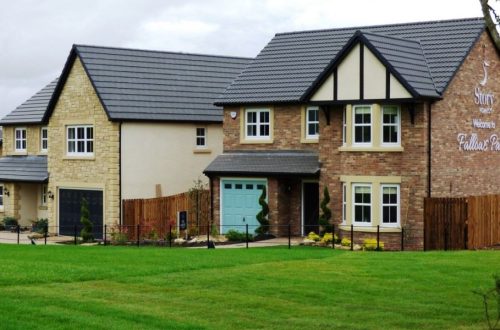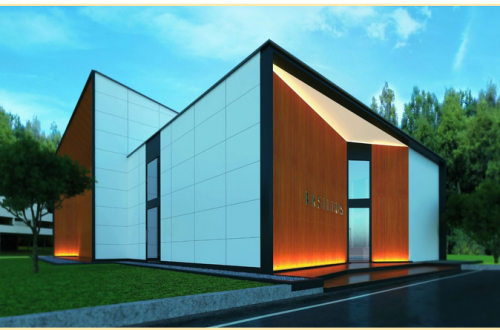Artificial grass for pets has come a long way from the stiff, plastic-looking turf of the past. Today’s pet artificial grass solutions prioritize comfort, safety, and environmental responsibility. For pet owners who want a clean, durable, and worry-free yard for their furry friends, dog friendly artificial grass—especially options that are 100% recyclable and latex free—offer the perfect blend of form and function. In this article, we’ll explore why pet friendly artificial grass is a game-changer, break down its most important features, and share practical tips on choosing, installing, and maintaining the best artificial grass for dogs and other pets.
1. Why Choose Pet Friendly Artificial Grass?
Safety & Comfort for Your Pets
Soft Underfoot, Gentle on Paws: Modern pet artificial grass is engineered with thicker, denser fibers and a cushioned backing layer to mimic the softness of natural turf—no more hot spots or rough, scratchy surfaces that can irritate paws.
Non-Toxic & Latex Free: Traditional infill materials and backings sometimes contain latex or chemicals that can cause allergies or irritate a pet’s skin. 100% recyclable latex free artificial grass removes that risk, offering a hypoallergenic surface that’s gentle on sensitive noses, paws, and skin.
Hygiene & Easy Cleanup
Impermeable to Stains and Odors: Most pet artificial grass systems include a permeable backing—often polyethylene-based—that allows liquids to drain straight through, preventing the buildup of odor-causing bacteria.
Simple Spot Cleaning: Accidents happen. A quick rinse with water, or a mild pet-safe cleaner, is usually all you need. No muddy paws tracked through the house, no dead patches from urine.
Durability & Longevity
High-traffic Resilience: Dogs love to run, dig, and play. Pet-friendly artificial grass is built to withstand heavy use, with UV-resistant fibers that won’t fade even under intense sun exposure.
Chew-Resistant Backing: Some products include specialized rub-resistant layers that deter dogs from clawing or attempting to dig beneath the turf.
Eco-Conscious & Sustainable
100% Recyclable Construction: When your pet grass has served its decade or more of loyal service, it won’t end up in a landfill. Look for systems labeled “100% recyclable,” meaning every component—from turf blades to backing—is accepted by specialized recycling facilities.
Latex Free = Less Environmental Impact: Latex production can be resource-intensive and may involve chemical processing. A latex free artificial grass solution reduces reliance on natural latex, addressing both environmental and allergy concerns.
2. Key Features to Look For
Fiber Composition & Pile Height
Ultra-Soft Polyethylene Blades: Polyethylene fibers bend more easily than polypropylene, making them ideal for preventing abrasions on delicate paw pads.
Pile Height of 1.5–2.0 Inches: This range offers the right balance of “fluffiness” and resilience. Shorter piles (under 1”) tend to feel too hard; taller piles (over 2”) may mat down quickly.
Drainage System
Perforated, Permeable Backing: Look for backing with micro-perforations or a porous foam layer that channels liquids directly into the ground. Avoid turf with a solid latex backing, which can trap moisture and produce odors.
Infill Compatibility: While some pet artificial grass products don’t require infill, many include antimicrobial silica sand or specially treated zeolite infill designed to neutralize ammonia from urine. Verify that any infill used is also latex free.
UV Stabilization & Colorfastness
UV-Protected Fibers: Intense sun exposure can cause turf blades to become brittle or fade. Premium dog friendly artificial grass often has UV inhibitors woven into the polyethylene to preserve color and strength.
Color Variation & Thatching: A natural-looking mix of light and dark green fibers, plus brown thatch (a low-lying brown layer beneath the green blades), creates a more realistic lawn that hides pet messes and wear patterns.
Environmental Certifications
Recyclability Claims: True 100% recyclable artificial grass will explicitly state the type of polymers used and reference certifications or partnerships with recycling programs.
Latex Free Labeling: If latex is absent from both the blade fibers and the backing, it should be clearly labeled as such. This also typically implies the turf is free from other common irritants like lead, cadmium, and volatile organic compounds (VOCs).
3. Benefits of 100% Recyclable, Latex-Free Artificial Grass for Pets
Health & Allergy Considerations
Reduced Risk of Allergic Reactions: Latex allergies aren’t limited to humans. Dogs and cats with sensitive skin can develop dermatitis if they’re repeatedly in contact with latex. Latex free artificial grass eliminates that worry entirely.
Chemical-Free Peace of Mind: Many latex free products also avoid other chemical treatments—no heavy metals, flame retardants, or pesticides. If your pet licks or lies on the turf, you’ll know it’s free of harmful residues.
Sustainability & Lifecycle Management
Circular Economy: At the end of its usable life (often 10–15 years), the turf can be collected, shredded, and remolded into new lawn blades, sports fields, or landscape materials—drastically reducing landfill waste.
Minimal Water Usage: Natural grass demands frequent watering, especially in hot climates. Artificial turf slashes water consumption, helping conserve a precious resource.
Aesthetics & Year-Round Appeal
Consistently Lush Appearance: No more brown patches from dog urine, seasonal browning, or muddy holes from digging. Your yard remains picture-perfect in every season.
Enhanced Property Value: A low-maintenance, pristine lawn can boost curb appeal—particularly attractive to future homebuyers who are also pet lovers.
4. Installation Tips for Pet Artificial Grass
Proper Base Preparation
Excavation & Grading: Remove existing sod or concrete to a depth of 3–4 inches. Slope the sub-base slightly (about 1–2% grade) to ensure water drains away from the home’s foundation.
Layered Aggregate Base: Compact a crushed stone or decomposed granite base (about 2–3 inches) using a plate compactor. This provides stability and prevents shifting when pets run or dig.
Adding a Functional Infill (Optional)
Antimicrobial Sand or Zeolite: For households where multiple dogs or frequent “accidents” occur, apply a fine layer of antimicrobial infill. This chemically treated sand neutralizes ammonia and helps control odors. Because the target turf is latex free, be sure any infill used is also chemical-safe and free of latex binders.
Edge Restraints & Seaming
Securing the Turf Edges: Use specialized edging spikes or stakes to prevent curled edges and reduce the chance of a curious pup trying to tug at the turf seams.
Seam Tape & Adhesive: If multiple turf rolls are needed, use high-quality, latex-free seam tape and adhesive designed for pet environments. Ensure seams are compressed tightly so there are no visible gaps or raised sections where dirt can accumulate.
Finishing Touches & Landscaping Integration
Rock or Gravel Borders: Installing small rock or crushed stone borders around the perimeter helps with drainage and discourages dogs from digging at the very edges.
Pet-Safe Plantings: Surround artificial turf with pet-friendly shrubs (e.g., rosemary, lavender, catmint) to create a stimulating environment. These plants discourage digging and offer sensory enrichment.
5. Maintenance & Longevity
Routine Debris Removal
Weekly Brushing: Use a leaf rake or stiff-bristled push broom to brush the fibers and redistribute any infill. This keeps the grass looking upright and prevents matting in high-traffic zones.
Spot Rinse After Accidents: Immediately rinse areas where pets relieve themselves with a hose. For stubborn spots, dilute a pet-safe enzyme cleaner with water and lightly mist the area, then rinse.
Deep Cleaning & Disinfection
Quarterly Washdown: Every three months (or more often, depending on usage), flush the entire lawn with water. If needed, add a small amount of vinegar or a commercially available turf disinfectant to eliminate lingering bacteria.
Inspect for Wear & Tear: Check seams, edges, and any high-wear zones. Repair minor tears promptly using a patch kit, ensuring your 100% recyclable, latex-free turf remains intact and safe.
Preventing & Addressing Odors
Ammonia Neutralizers: If you notice a persistent odor, sprinkle granular zeolite directly onto the turf surface. Let it sit for several hours before rinsing with water.
Regular Sun Exposure: Design your yard so that artificial grass gets direct sunlight whenever possible; UV rays help naturally sanitize and reduce bacteria buildup.
Prolonging the Turf’s Useful Life
Rotate Heavy Furniture & Bowls: If you place dog crates, feeding stations, or outdoor furniture on the turf, rotate their positions every few months to prevent permanent depressions.
Avoid Open Flames & Chemicals: Never grill directly on artificial grass—exposed plastic can melt. Similarly, avoid using harsh solvents or bleach, which can degrade fibers over time.
6. Finding the Right Supplier & Product
Certifications & Warranties
Look for GREENGUARD or OEKO-TEX Certification: These third-party labels ensure the turf fibers meet strict chemical emission standards, verifying they’re free from harmful substances.
Minimum 10-Year Warranty: A solid warranty typically covers fading, backing failure, and fiber wear. Extended coverage often indicates the manufacturer’s confidence in a latex-free, recyclable product.
Ask About Lifecycle Programs
Take-Back & Recycling Plans: Responsible manufacturers will outline a clear path for reclaiming old turf at the end of its life—sometimes even offering credits toward new installations.
Local Recycling Facilities: Confirm that the turf can be processed by recycling centers in your region. A truly 100% recyclable system should not require shipping thousands of miles at the end of its lifecycle.
Third-Party Reviews & Real-World Testing
Pet Owner Testimonials: Read reviews from households with multiple dogs or high-energy breeds. First-hand feedback on odor control, puncture resistance, and longevity helps you set realistic expectations.
Professional Installers’ Insights: Many landscaping companies have experience with different turf brands—ask for their recommendations on which 100% recyclable, latex-free pet artificial grass stands out in your local climate (e.g., hot summers, heavy rainfall).
7. Real-World Examples & Case Studies
Urban Backyard Transformation
A couple in Austin, Texas, replaced their patchy, mud-prone lawn with a dog friendly artificial grass system featuring antimicrobial infill and a latex-free backing.
Results: No mud, no yellow patches from urine, and a 75% reduction in water usage during peak summer months. Their two Labrador Retrievers love lounging on the plush surface.
Multi-Dog Household Solution
A family with three Husky mixes in suburban Chicago needed a low-maintenance, odor-immune play area. They installed a 2-inch pile, UV-stabilized, recyclable turf with a welded backing (free of latex).
Outcomes: After two winters and one intense summer season, the turf remained vibrant, drained quickly after ice-melt runoff, and housed no lingering smells—even with multiple nightly potty breaks.
Commercial Pet Daycare Installation
A dog daycare facility in Los Angeles opted for industrial-grade, latex-free artificial grass laid over a high-capacity drainage base.
Findings: The daycare reported 30% fewer slip-and-fall incidents among dogs, zero mud tracked into the building, and negligible odor complaints from patrons—boosting their five-star online reviews.
8. Frequently Asked Questions (FAQs)
Q1: Can my dog still dig on artificial grass?
A: While no turf can entirely eliminate digging instincts, dog friendly artificial grass often includes a tight, interlocking backing that makes digging more difficult. Border materials—like crushed stone or river rock—can further discourage dogs from clawing at the edges. If you have a habitual digger, consider designated digging areas filled with pet-safe sand to redirect the behavior.
Q2: Will artificial grass get too hot in the sun?
A: Artificial turf can absorb heat, sometimes reaching surface temperatures higher than natural grass. Many pet artificial grass products incorporate heat-reflective pigments or use lighter green shades to reduce heat buildup. Additionally, regular misting with a garden hose can cool the surface before your dog goes outside. Shaded areas (e.g., under trees or canopies) also help keep the surface at a comfortable temperature.
Q3: How long does 100% recyclable, latex-free artificial grass typically last?
A: High-quality pet turf can last anywhere from 10 to 20 years, depending on usage, climate, and maintenance. The latex-free backing tends to be more UV and moisture resistant, reducing the chance of backing breakdown over time. Regular brushing and periodic infill replenishment (if used) help maximize lifespan.
Q4: Is artificial grass safe if my dog likes to chew?
A: No material is entirely chew-proof—some dogs will nibble on blades out of boredom. However, the fibers used in premium dog friendly artificial grass are usually too tough to chew through easily. If your dog does manage to chew a small piece, it’s non-toxic—as long as the turf is certified latex free and made without lead, cadmium, or harmful glues. Still, keep an eye on any persistent chewing behavior and provide alternative chew toys to discourage turf-shredding.
Q5: How do I dispose of or recycle my old artificial grass?
A: 100% recyclable artificial grass can be taken to specialized recycling centers that process polyethylene fibers and polymer backings. Some manufacturers even offer “take-back” programs: once your turf is worn out, they’ll collect and recycle it, often providing a discount on a new installation. Always verify local recycling options before installing, as not all municipal facilities accept turf materials.
Investing in a pet friendly artificial grass system—particularly one that is 100% recyclable and latex free—brings a myriad of benefits for both pet owners and the environment. From soft, non-irritating surfaces that keep paws happy, to easy cleanup routines and long-term cost savings on water and maintenance, dog friendly artificial grass represents the future of pet-safe landscaping. By choosing a high-quality, environmentally responsible product, you give your pets the best play space possible while reducing your carbon pawprint. Whether you’re tackling muddy paws, grass burn from urine, or the challenge of a chewing canine, this next-generation turf has you covered—literally and sustainably.
Enjoy a perfectly green, odor-free yard for years to come, knowing that when it eventually comes time to replace the turf, your old grass will be recycled into something new—continuing the eco-friendly cycle (and giving your pets another soft, safe surface to enjoy in the future).





